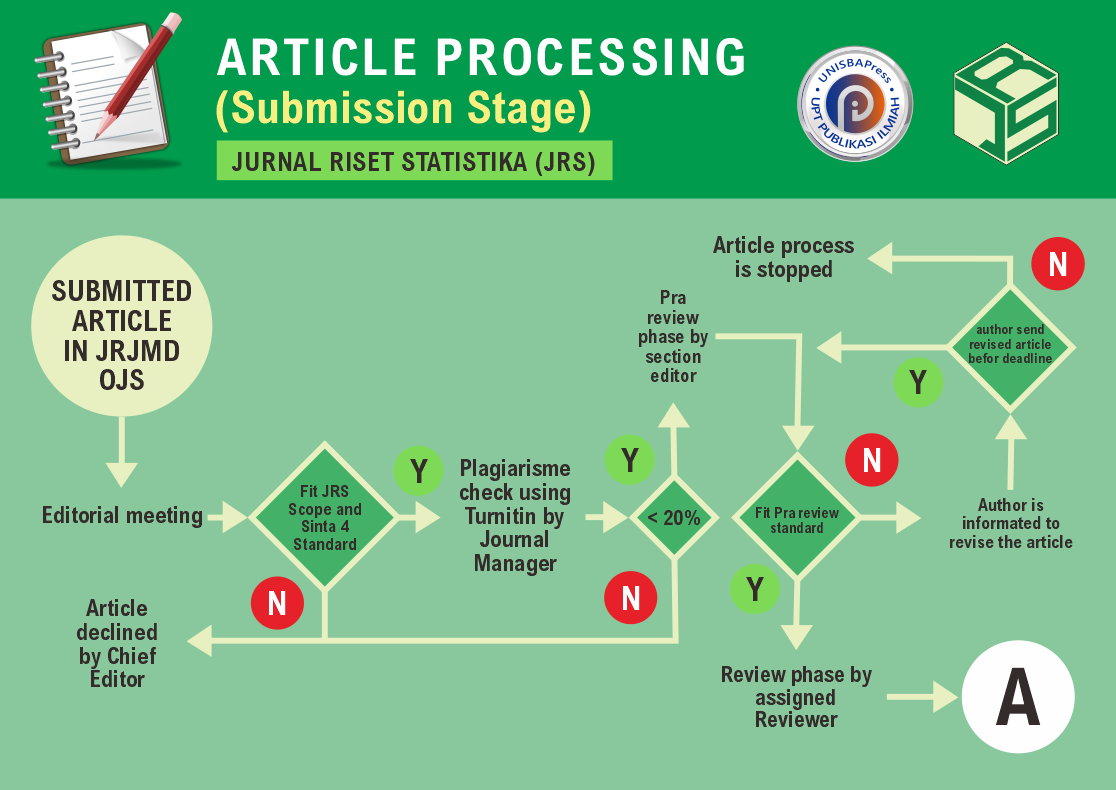Penerapan Metode Generalized Structure Component Analysis pada Pengguna Dompet Digital Menggunakan Model UTAUT 2
DOI:
https://doi.org/10.29313/jrs.v3i1.1772Keywords:
Structural Equation Modeling, Generalized Structure Component Analysis, UTAUT 2Abstract
Abstract. Structural Equation Modeling (SEM) is a multivariate analysis method that combines factor analysis, path analysis, and regression analysis. Structural Equation Modeling (SEM) aims to measure the relationship between latent variables and their indicators. Component-based SEM has two methods, namely Partial Least Square (PLS) and Generalized Structure Component Analysis (GSCA). In this study the focus is on component-based SEM analysis, namely the Generalized Structure Component Analysis (GSCA) method. Generalized Structure Component Analysis (GSCA) is a method that does not require multivariate normal distribution assumptions and has an overall goodness of fit measure. The parameters used are factor loading, parameter coefficients, weight of indicators and estimation with Alternating Least Square (ALS). This study aims to determine what factors in the UTAUT 2 modification model influence the intention and behavior of using digital wallets (e-wallets) in Rajamandala Kulon village. The results of this study are that habit and security factors are felt to have the highest influence on usage intentions and habit factors and usage intentions have the highest influence on digital wallet usage behavior in Rajamandala Kulon Village.
Abstrak. Structural Equation Modeling (SEM) merupakan salah satu metode analisis multivariat (multivariate analysis) yang menggabungkan antara analisis factor, analisis jalur, dan analisis regresi. Structural Equation Modeling (SEM) bertujuan untuk mengukur hubungan antara peubah laten dan indikatornya. SEM berbasis komponen memiliki dua metode yaitu Partial Least Square (PLS) dan Generalized Structure Component Analysis (GSCA). Pada penelitian ini fokus pada analisis SEM berbasis komponen yaitu metode Generalized Structure Component Analysis (GSCA). Generalized Structure Component Analysis (GSCA) merupakan metode yang tidak memerlukan asumsi distribusi normal multivariat dan memiliki ukuran overall goodness of fit. Parameter yang digunakan adalah factor loading, coefficients parameter, weight of indicators dan estimasi dengan Alternating Least Square (ALS). Penelitian ini bertujuan untuk mengetahui factor -faktor apa saja dalam model modifikasi UTAUT 2 yang berpengaruh kepada niat dan perilaku penggunaan dompet digital (e-wallet) di desa Rajamandala Kulon. Hasil dari penelitian ini adalah faktor kebiasaan dan keamanan yang dirasakan memiliki pengaruh tertinggi terhadap niat penggunaan serta faktor kebiasaan dan niat penggunaan memiliki pengaruh tertinggi terhadap perilaku penggunaan dompet digital di Desa Rajamandala kulon.
References
W. Novian and M. Herlina, “Faktor-faktor yang Mempengaruhi Perilaku Masyarakat terhadap Penggunaan Internet pada Desa Digital Sukaraja,” Jurnal Riset Statistika, pp. 161–168, Dec. 2022, doi: 10.29313/jrs.v2i2.1466.
F. Fitriani, A. Rusgiyono, and T. Widiharih, “Penerapan Metode Generalized Structured Component Analysis pada Kepuasan Konsumen (Studi Kasus: Pasien Klinik Q),” JURNAL GAUSSIAN, vol. 9, no. 4, pp. 454–463, 2020, [Online]. Available: https://ejournal3.undip.ac.id/index.php/gaussian/
H. Hwang and Y. Takane, “Generalized structured component analysis,” Psychometrika, vol. 69, no. 1, pp. 81–99, Mar. 2004, doi: 10.1007/BF02295841.
R. Alvaro and E. Octavia, “Desa Digital: Potensi dan Tantangannya,” A. N. Aida and M. Nasution, Eds., 08 ed.2019, pp. 8–11. [Online]. Available: www.puskajianggaran.dpr.go.id
V. Venkatesh, J. Y. L. Thong, and X. Xu, “Consumer Acceptance and Use of Information Technology: Extending the Unified Theory of Acceptance and Use of Technology,” MIS Quarterly, vol. 36, no. 1, pp. 157–178, 2012, doi: 10.2307/41410412.













